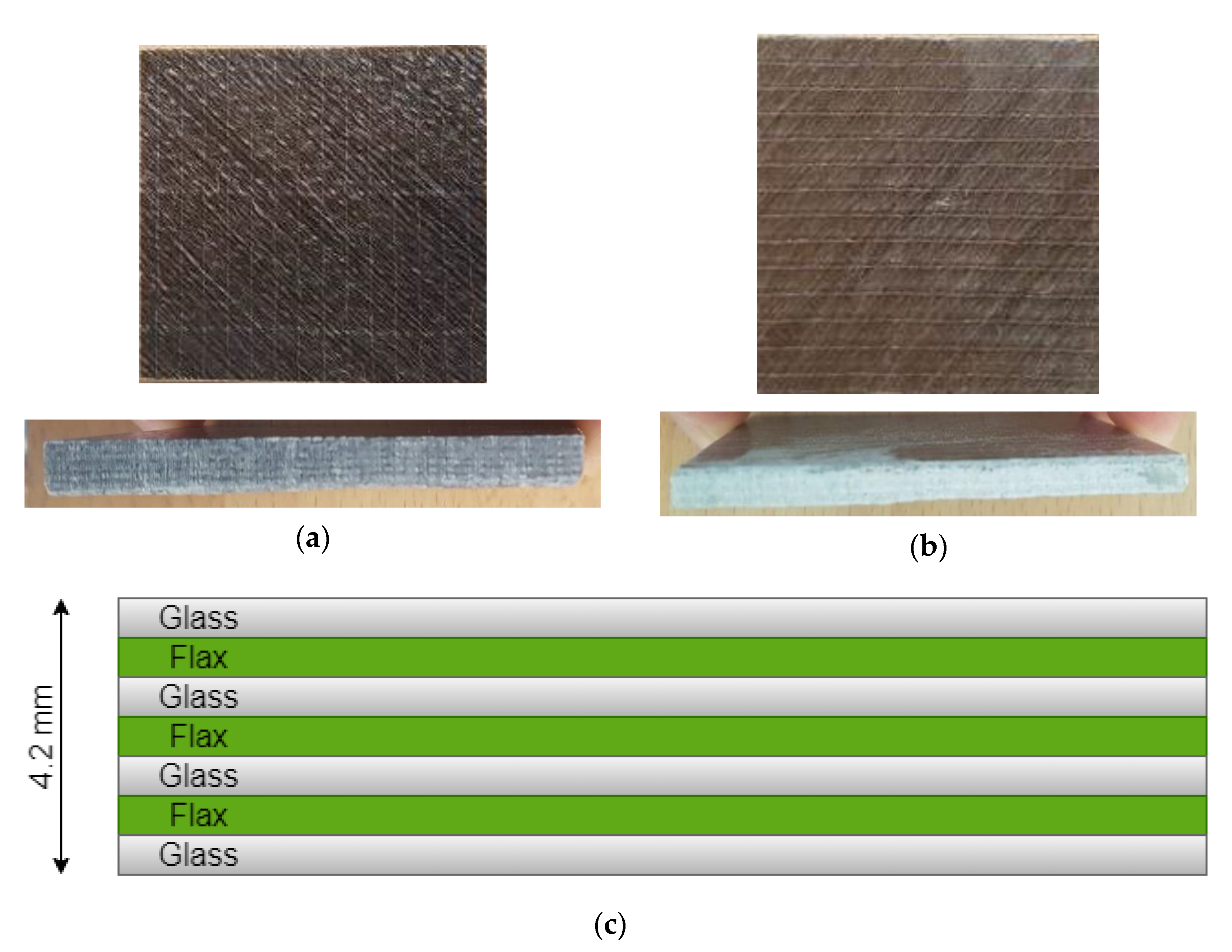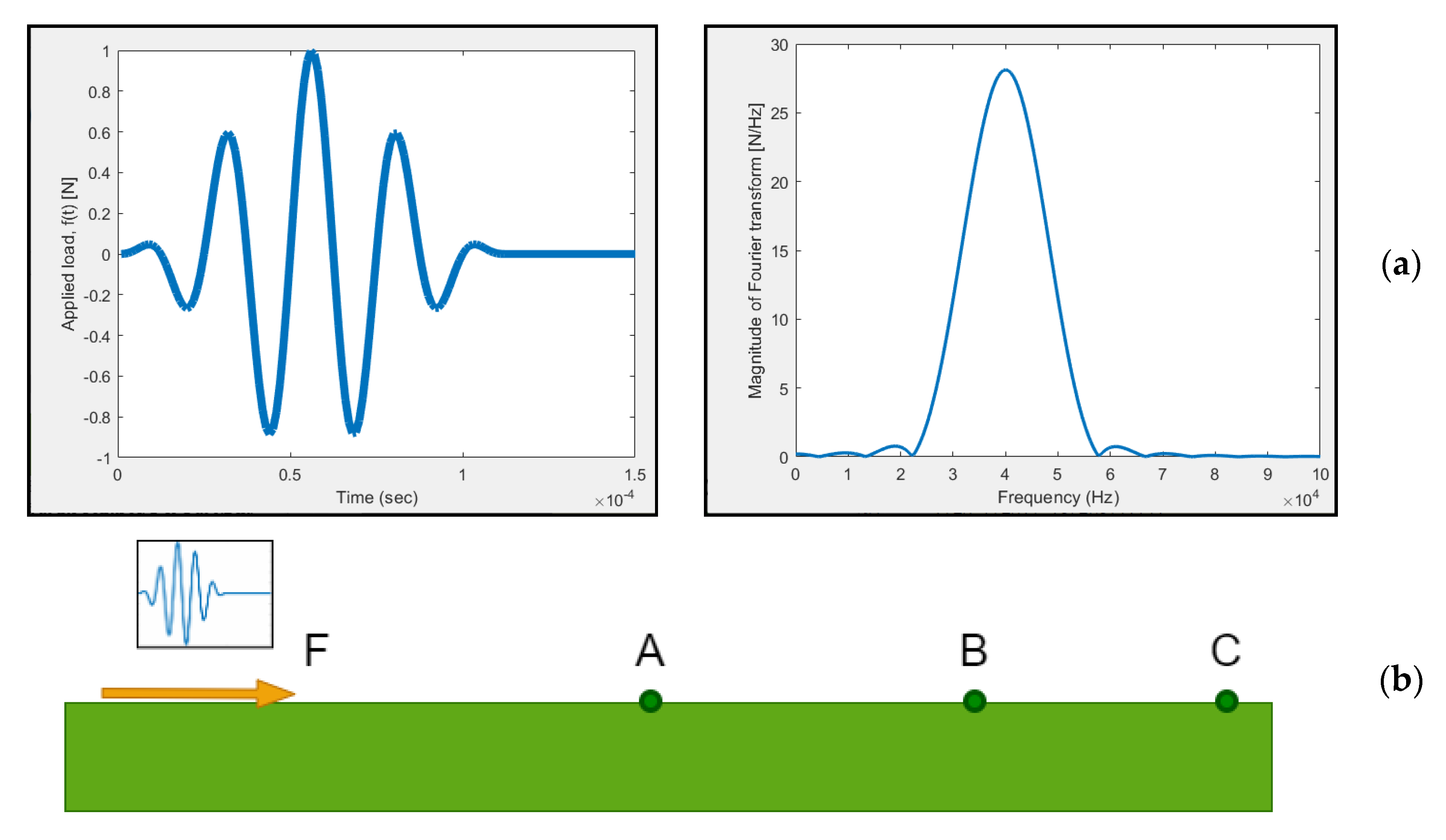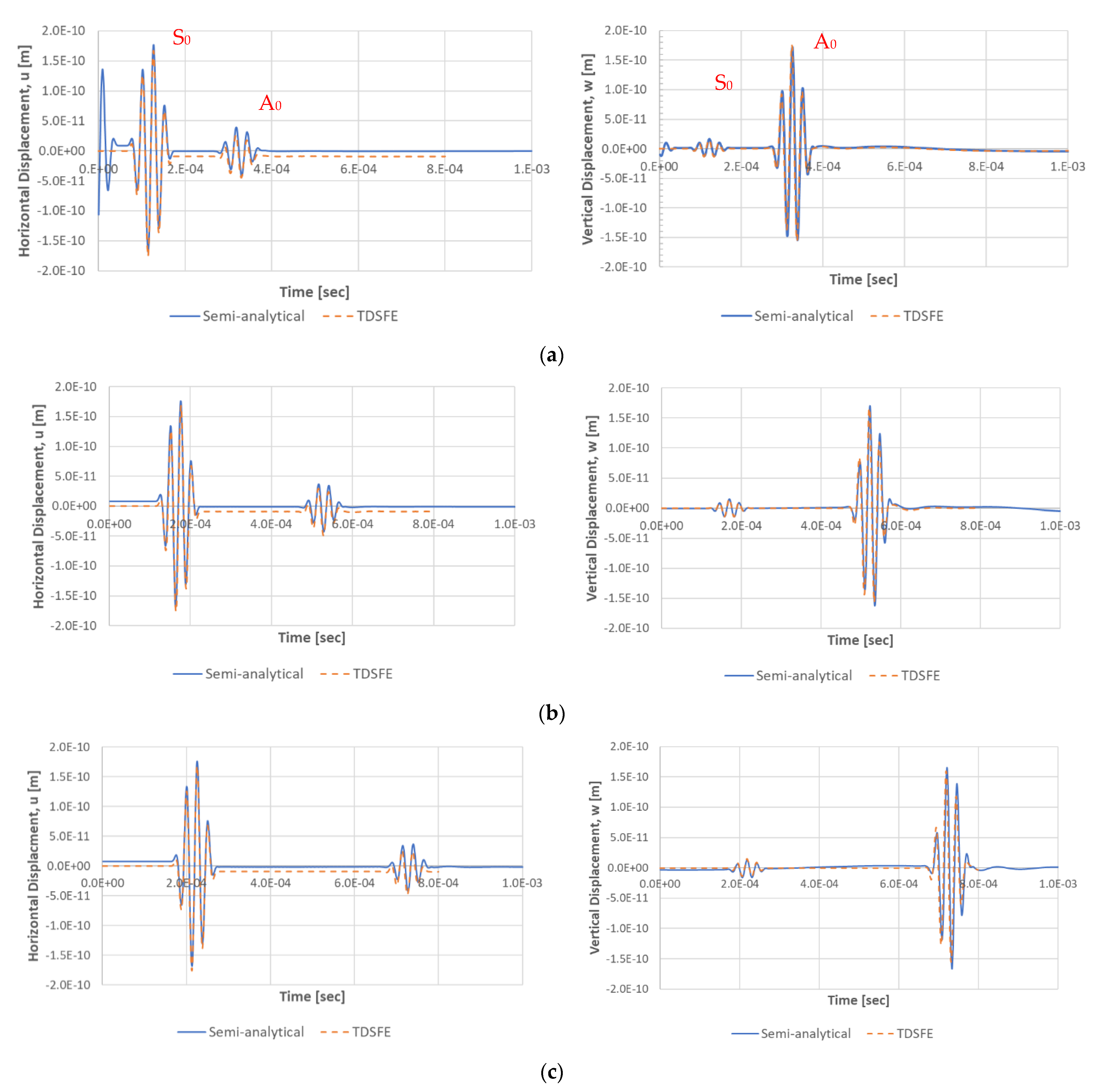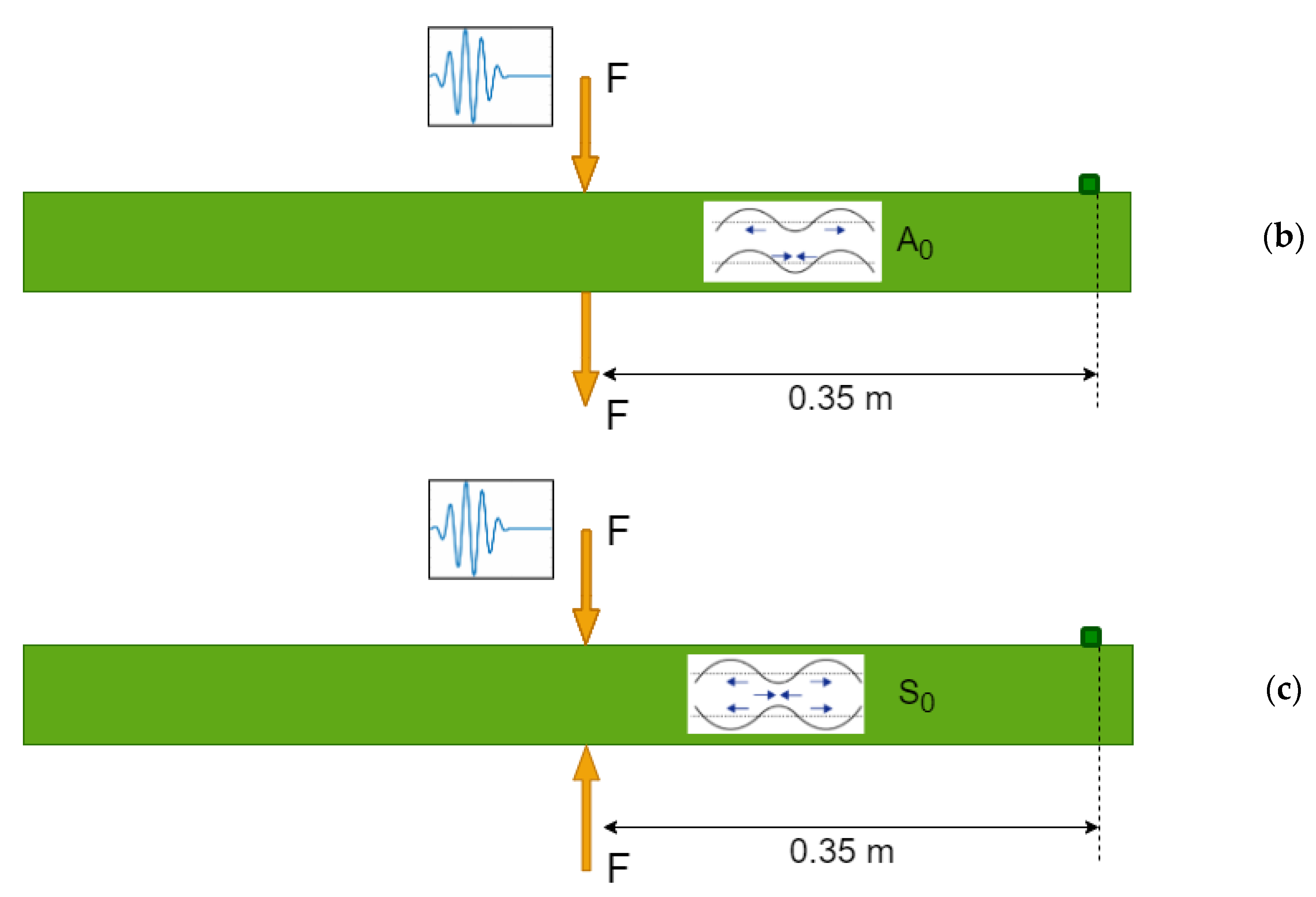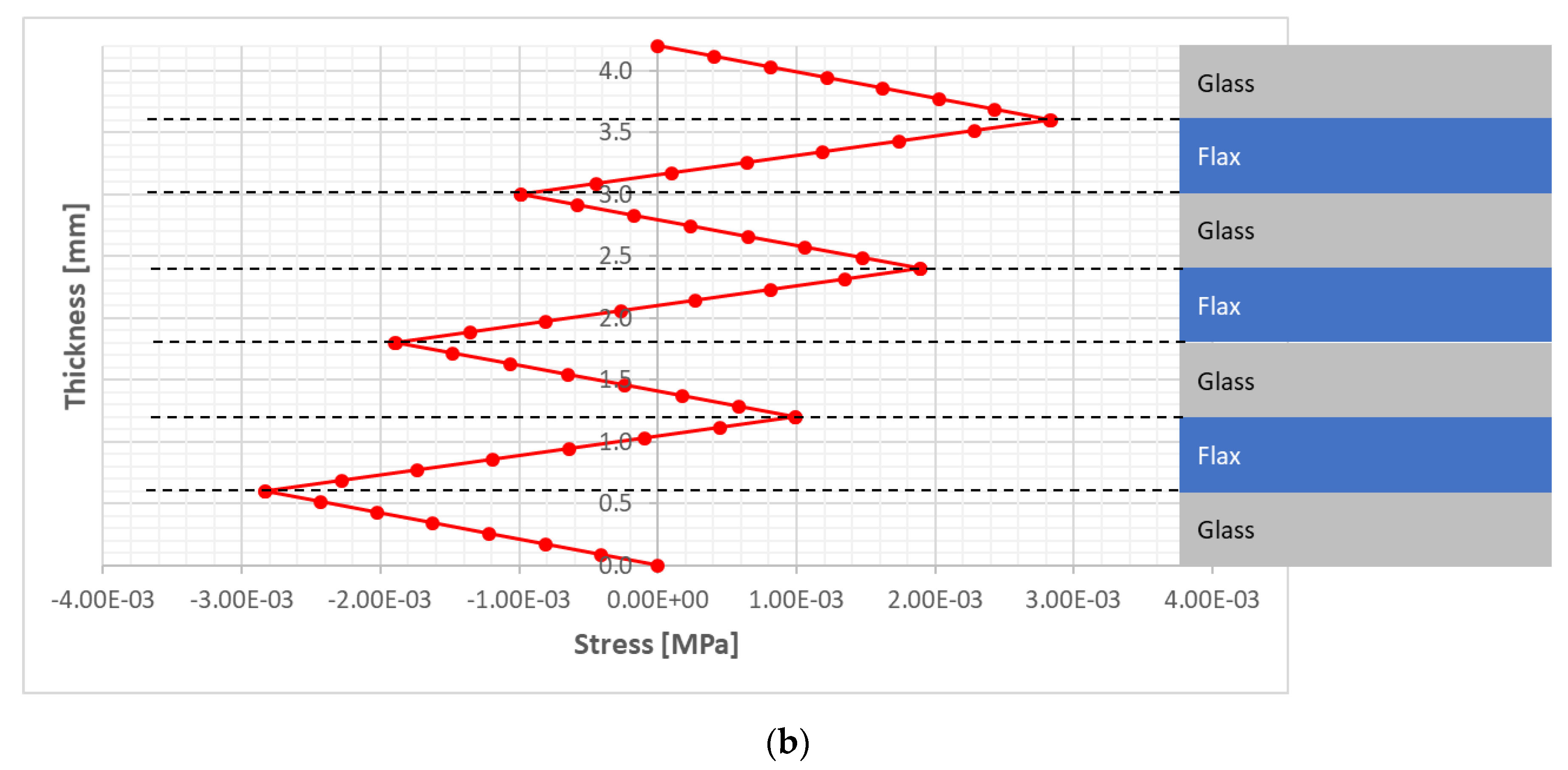1. Introduction
Natural fiber-reinforced plastics have gained increasing interest among various industrial applications, such as automotive, maritime structures, buildings and infrastructure as well as food containers. The increasing negative effect on the environment and climate change as a result of the increasing use of fossil-based materials has driven the interest worldwide from nonrenewable fossil-based composite reinforcements (such as glass and carbon fibers) to more sustainable and environmentally friendly materials, such as plant fiber-based reinforcements [
1,
2,
3]. Their very good mechanical properties, combined with their lightweight structure and their environmentally friendly nature and recyclable properties have made them replace conventional composites often in secondary structures and, in some cases, in load-bearing primary structures. The main advantage of natural fibers lies in their environmental attributes; being biodegradable, recyclable and renewable makes them attractive for various applications, considering also the mitigation of energy required to be consumed for their production and processing compared to carbon and glass fibers [
4,
5].
The need to investigate the health status of structures via different nondestructive testing (NDT) methods and decide on their structural health condition is crucial in any application. Structural health monitoring (SHM) of composite structures using wave propagation methods has been used extensively the last decades in order to identify, locate and measure the size and depth of defects and cracks in those structures [
6]. Analyzing the wave characteristics of structures and the propagation of elastic waves through media and components has been attempted from many researchers and has been implemented in real applications. Numerical and experimental methods are compared and validated in order to provide a robust strategy in the damage identification problem within a structure [
7]. The findings from the investigation of the damage state in composite structures using wave propagation methods become hard to interpret because of the complex nature of the material, its heterogeneity and layered structure. In these structures, their geometry and anisotropic material behavior are complicated, any analytical solutions become difficult and sometimes impossible to formulate and, hence, solve. Therefore, semi-analytical and numerical methods have been developed for the computation of dispersion curves and the simulation of the propagation of stress waves within these structures. Solutions for 2D strips and 3D plates provide a very good understanding of the ultrasonic waves that propagate and their characteristics [
8,
9,
10]. The application of finite spectral elements has been also used to simulate and understand the one-dimensional propagation of elastic waves in rods and beams where their efficiency has been proved over the classic finite element approach [
11]. Other solutions involve the use of piezoelectric actuators and sensors for the excitation of the structures and detection of its behavior [
8,
12].
The use of wave propagation methods in conventional composites is extensively used in a wide range of applications and structures. However, the use of these methods on sustainable, natural fiber composites is very limited and only a few works have been focused on this direction. Studies where various structural health monitoring methods have been applied to both conventional and natural fiber composites and comparing their capabilities have provided interesting outputs. Most of the SHM methods can be equally applied to both material systems with relative sensitivity. The use of visual inspection methods and piezoelectric actuators was implemented in wind turbine blades made out of glass fiber composite and flax fiber composite when a lightning strike was experimentally simulated, and the results were compared [
13]. The comparison revealed that the SHM methods were applicable to both material systems and concluded that the flax reinforced-composite could be a good replacement of glass fibers. Generally, the effective application of an SHM technique strongly depends on the deep understanding of the mechanical properties of the material [
14]. Especially with the hybridization of the natural fiber composites with synthetic fibers to enhance their performance, the understanding of the damage mechanisms has become even more challenging in terms of interpreting the outcomes of SHM methods. An interesting approach was attempted by Muda and Mustafa [
15], where a kenaf composite patch was attached to a carbon fiber aircraft panel and its performance was monitored and detected under mechanical testing using piezoelectric patches. The resemblance of the signals detected from both the undamaged and the patched specimens indicates that the SHM method used can be sensitive for natural fibers as well and that kenaf reinforced patches are a promising alternative in repair applications. The experimental extraction of dispersion curves for flax fiber composite panels have been attempted having good agreement with numerical results [
16], where both the finite element (FE) and the wave finite element (WFE) methods were used and compared. Other ultrasonic testing methods have been used in order to investigate the effect of the parameters of the composite on the sound speed of the propagating wave [
17]. In this case, the characteristics of the propagating waves and their changes due to the fiber content or humidity within the structure determine the state of the structure and become a tool for its evaluation. It is a fact that water and moisture absorption tendency of the flax fibers is a factor that reduces their composites’ rigidity and needs to be well understood [
18]. This process was extended to the full characterization of fiber content and distribution of flax reinforced composites in [
19], where empirical models were proposed to correlate fiber content with longitudinal sound speed and attenuation coefficient. Recent studies have been conducted on experimental investigation of acoustic and vibration characteristics of flax fiber-reinforced composites, by studying the changes in natural frequencies and damping characteristics of the structures under various loading conditions [
20]. The study concludes that this material could be used as a noise mitigation solution in aircraft and marine industry with low and medium frequency range. In another study, the vibroacoustic behavior of biodegradable composites with natural fibers was studied, where the type of the plasticizer used in the composite changes the suppression parameter of vibroacoustic behavior [
21]. The thermomechanical properties of natural fiber polymer composites are very important, especially around the interface between the matrix and the reinforcement. Very recent studies [
22] evaluate the influence of thermal stresses on the fiber–matrix interface using jute fibers as reinforcement and the results were verified with nonlinear acoustic techniques. However, the ultimate aim of these studies is to evaluate, identify and locate the damages within the structures. Acoustic emission is one of the most widely used methods for this purpose and it has been used for flax-reinforced composites to study the sensitivity of sound waves to crack propagation [
23]. The importance of assessing wave characteristics of newly developed and promising materials, such as natural fiber composites, has motivated this study, given the growing interest of the automotive and energy sector on these materials. The increasing interest in the design of new sustainable materials and their implementation in various structural components has driven the authors to investigate and understand how stress waves would travel in these materials and the potential of using wave propagation methods as a damage identification and localization method in these materials.
Although pure analytical approaches offer fast and accurate results, their formulation for laminated composite plates is complicated and cumbersome, hence they are effectively limited to rather simple geometries and material configurations. On the other hand, common numerical methods, such as finite element and finite difference methods, require very high spatial discretizations over the plane of the plate and through the thickness to yield converging solutions in terms of wave dispersion data and group velocities. Particularly, at high ultrasonic frequencies, where more complex wave modes are excited, the application of numerical methods becomes a computationally intractable task, involving an extremely high number of elements. This has driven research towards more efficient semi-analytical methods for the prediction of guided waves in laminated composite plates improving the robustness, accuracy and computational speed for the solution extraction. The incorporation of 2D or 3D layerwise laminate plate theories in semi-analytical solutions has increased their popularity and accuracy in wave propagation problems. Similarly, the application of explicit time domain spectral finite element (TDSFE) method combines several advantages over the classic finite element methods, especially because of the layerwise configuration through the thickness of the laminate, making it ideal for capturing of the propagation of Lamb waves.
In this paper, the propagation of stress waves in flax fiber reinforced composite strips is being investigated and verified using two different methods. A semi-analytical method, that utilizes the layerwise theory for the through-the-thickness displacement field and an analytical expression of the displacement along the length of the strip, is compared to a time domain spectral finite element (TDSFE) method, where third order Hermite polynomial splines are employed for the approximation of displacements through the thickness. Three different material configurations are used, namely a unidirectional flax-PE (PE: Polyethylene) composite strip, a woven flax fiber-reinforced composite strip and a hybrid flax/glass fiber reinforced-vinylester composite strip. The first case was verified with already existing literature. For the last two cases, both methods provided an excellent agreement for the time response. Further to this, through-the-thickness displacement field variations as well as stress and strains were presented, and the complex nature of the composites was captured.
2. Theoretical Background
For the formulation of the problem, the layerwise theory was used for the kinematic assumptions through the thickness of the composite strip, whereas an analytical approach of displacement was implemented along the length of the strip [
9,
10].
Considering the stress equilibrium equations for a plane strain problem (as depicted in
Figure 1b):
where
are the normal and shear stresses;
u,
w are the displacement components along
x and
z axes, respectively;
ρ is the density of the medium; the “comma” subscript denotes differentiation with respect to
x or
z; whereas double dots denote differentiation with respect to time.
The kinematic assumptions for the displacement field through the thickness of the laminate, as derived using the layerwise theory are given by:
where superscripts
indicate the discrete layer,
are the in-plane displacements at the interfaces of each discrete layer along the
x and
z axes, respectively, and
are linear interpolation functions through the laminate thickness for the
nth layer, as shown in
Figure 1c. Substituting Equation (2) into the equilibrium Equation (1), using strain-displacement relations and applying an analytic Fourier transform both in the time and space domain, the final problem becomes:
where the matrices
represent the generalized in-plane and out-of-plane system matrices,
are the generalized laminate mass matrices,
and
are the shear and normal external forces, respectively,
is the frequency and
is the wavenumber, as extracted by the Fourier transforms. The solution of the homogeneous system of Equation (3) yields the dispersion relation for elastic guided waves in 2D strips.
Using the necessary transformations, Equation (3) can be solved for a specific excitation frequency and yield the corresponding wavenumbers. Then, the inverse Fourier transform is used twice to return the time-space domain and receive the solution of the problem.
The multi-field cubic spline layerwise theory is formulated for composite and sandwich laminates to capture straight-crested symmetric and antisymmetric stress waves. Third order Hermitian polynomials are employed in the approximation of displacements through the thickness. The multinode TDSFE formulation entails displacement degrees of freedom at nodes collocated with Gauss–Lobatto–Legendre integration points facilitating the formulation of semidiagonal mass matrices. The third order through-the-thickness approximation, as well as the high order Lagrangian C
0 polynomial shape functions minimize the discretization effort through the thickness to one layer per material and to 5.5 nodes per wavelength along the strip’s length in order to attain a converged and accurate solution [
8].
3. Materials and Fabrication
In this work, the dispersion characteristics of a flax fiber-reinforced composite material are extracted and compared with experimental results from already existing literature [
16]. A unidirectional flax fiber-reinforced composite laminate was used with polyethylene (LLPDE) film used as matrix material and total laminate thickness of 3.6 mm.
Then, a flax/vinyl ester woven laminate and a hybrid flax-glass fiber reinforced vinyl ester composite material are investigated and Lamb wave propagation is examined. The matrix material used was vinyl ester resin (Scott Bader Crystic VE676-03) and at 1.5% catalyst weight was used to cure. The reinforcement was woven flax with fiber orientation [±45]3s biaxial stitched noncrimp fabrics of 600 g/m2 in aerial weight, supplied by Net Composites Ltd. Fiber volume fraction (FVF) was 49% and void content was about 4%.
Two types of composite laminates were used in this study: a flax fiber-reinforced vinyl ester (FVE) and a flax fiber-hybridised glass fiber hybrid (FGVE) composite laminate. These materials have been used previously in another study for different experimental testing [
24]. Images of the in-plane and cross-section of the laminates are depicted in
Figure 2a,b, respectively. The fabric configuration was 6 layers of +/−45° fabrics of glass and flax, with laminate thickness equal to 4.2 mm. The hybrid specimens were manufactured using 7 layers of G/F/G/F/G/F/G configuration, where G stands for glass and F for flax, with 4.2 mm laminate thickness (
Figure 2c).
The mechanical properties of the material are given in
Table 1.

